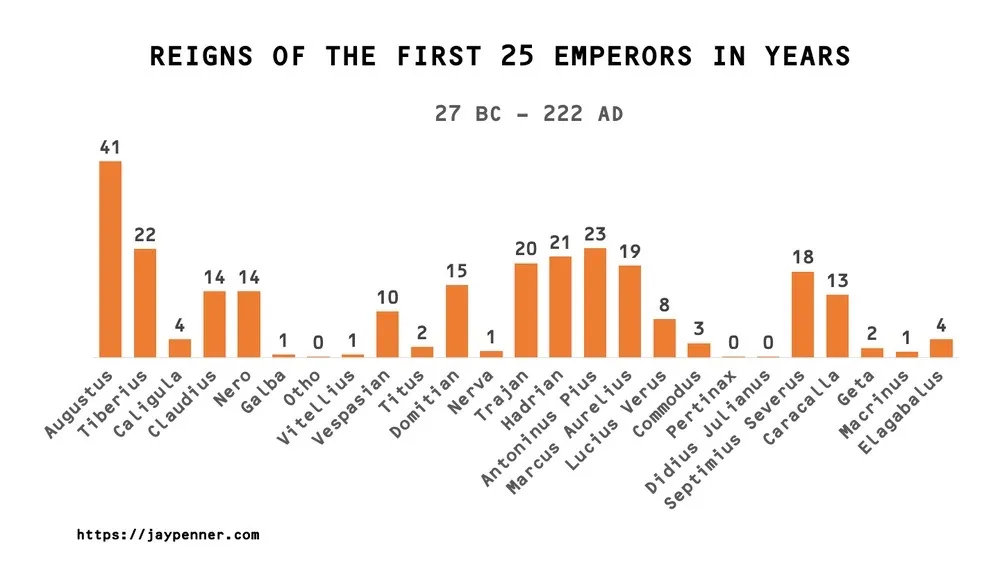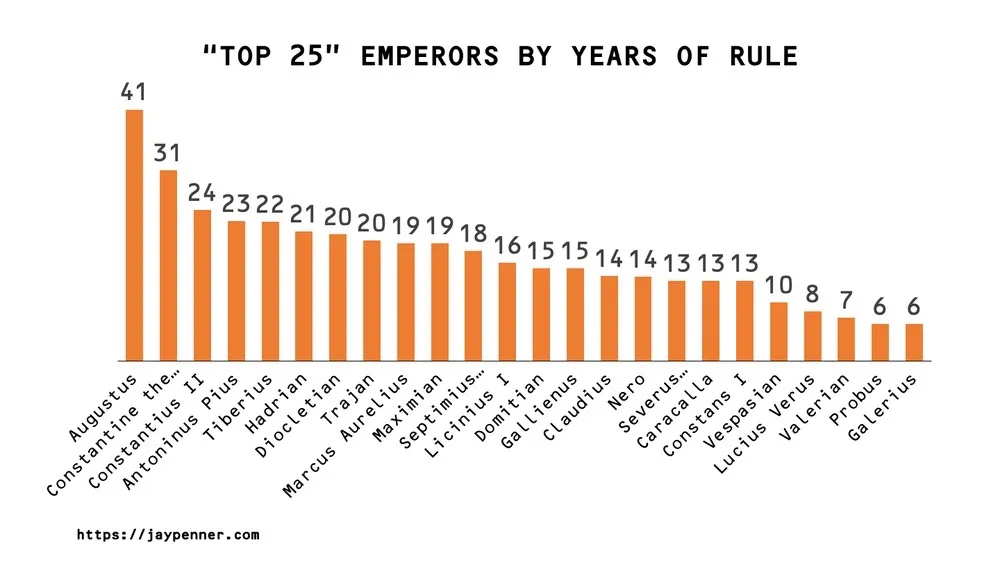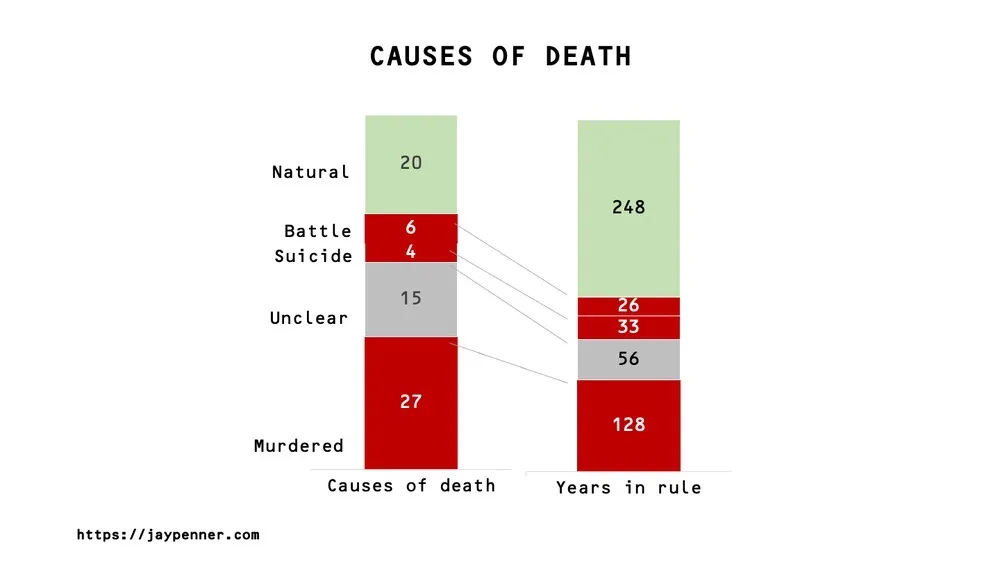ROMAN EMPERORS AND THEIR RULE
The Roman Empire represents a captivating epoch in history. While most of us are familiar with the renowned era of Caesar, Antony, and Octavian (later known as Augustus), there is less emphasis on the extensive reign of the emperors that spanned from Octavian in 27 BC to nearly 500 AD. This epoch was brimming with intriguing personalities and monumental events.
When we indulge in television series or movies centered around Rome, we seldom grasp the statistics of the era — precisely how many emperors existed? How extensive were their reigns? There’s a prevailing notion that an emperor would ascend to power, face assassination within a week, and voilà, his successor would emerge.
However, this wasn’t quite the norm.
This article aims to provide the reader with a perspective on the breadth and duration of this era, complemented by intriguing facts and insights.
Preliminary Notes:
The primary reference for much of the data presented here is derived from this Wikipedia link. Thus, the accountability for the choice of source and any potential inaccuracies rests with me.
It’s worth noting certain exceptions — some emperors shared their rule, the duration of others’ reign remains ambiguous, the details of some demises are uncertain, and I’ve approximated their rule to the nearest year. For instance, emperors who ruled for three months have been represented as 0.
Our exploration commences with (Octavian) Augustus Caesar, recognized as the inaugural Roman emperor from 27 BC. Remember that Octavian did not call himself Emperor, only that he was the “first citizen.”
Approximately 70 Roman emperors reigned from the inception (Augustus in 27 BC) to the culmination (Romulus Augustus in 476 AD). We’ll delve into the reigns of the initial 25 emperors, examining the approximate number of years each presided. It’s essential to acknowledge that while this sequence is chronological, there were instances of concurrent reigns.
Duration of Rule
The initial 25 Roman emperors and their respective reigns (in years):

Augustus, as the inaugural emperor, also boasts the title of the longest reigning emperor. It’s remarkable that, following the civil war, he managed to judiciously govern and expand a burgeoning empire for over four decades. It’s indeed an extraordinary tenure upon reflection!
A notable observation is the “era of proficient emperors” commencing with Trajan. While Domitian was a competent administrator, he was loathed by the Senate. Following his assassination and the brief rule of Nerva, Trajan ascended to power. He is lauded as one of the preeminent emperors in Roman annals. With him, we witness nearly 80 years of unbroken, stable governance. Romans of this era would have relished a predominantly placid epoch spanning almost their entire generation — from forebear to progeny, given the life expectancy of the time.
For those who have appreciated Ridley Scott’s “Gladiator”, it might be a common misconception that Commodus murdered his father, Marcus Aurelius, to become emperor. In actuality, Aurelius succumbed to natural causes, and Commodus had already co-ruled alongside him for three years. Lucius Verus wasn’t an intermediary between Aurelius and Commodus — he co-ruled with Aurelius, though he remains relatively obscure.
Let’s now turn our attention to those emperors who enjoyed the most extensive reigns.
The top 25 emperors by their years of rule

If you were born at the onset of Augustus’s reign, it’s highly likely you would have passed away before his tenure concluded, given that the average life expectancy at the time hovered around 35 years. Imagine, for a moment, living in a contemporary democracy with the same leader presiding throughout your entire lifespan.
Constantine the Great, acclaimed for instituting Christianity as the state religion, held the distinction of being the second-longest reigning Roman emperor.
Have many of us come across the name Constantius II? Even though he spent a portion of his reign as a co-emperor, he held the helm for close to a quarter of a century.
It appears that a tenure of 15-20 years presents a significant milestone, even for the most formidable emperors. My hypothesis is that, unless they began their rule at a young age (like Augustus), they inevitably grappled with the challenges of advancing age. Lacking the advanced medical interventions we possess today, many either succumbed to natural ailments or faced external threats, especially as they aged or exhibited signs of cognitive decline.
Consider Nero, whose leadership skills were far from exemplary. Living under his rule for 14 years would mean that if you embarked on your career following university graduation at the onset of his reign, you would have amassed nearly 15 years of professional experience by its end— a considerable span.
Valerian, with a reign of 7 years, bears the unique and unfortunate distinction of being the sole Roman emperor to perish in captivity. The circumstances surrounding his treatment by the Persians remain a topic of debate.
Now let’s look at causes of death

A remarkable 28% of Roman emperors who passed away due to natural causes were at the helm for just over half the entire duration of the empire’s existence. This suggests that extended, stable reigns were often helmed by competent emperors who adeptly navigated political intrigues and deterred assassination attempts.
Emperors who died of natural causes averaged reigns of around 12 years, while those who met violent ends averaged a mere 5 years. One could argue that the very character or governance style of certain emperors contributed to their untimely demises.
A staggering 51% of emperors met an unnatural death. If we factor in the emperors with ‘unclear’ causes of death, this statistic swells to 73%. As a Roman emperor, you faced a daunting 3 out of 4 odds that your demise would be far from peaceful or desired. (Take Domitian, for instance, who suffered the ignominy of a fatal stab to the groin—rather unfortunate!)
It’s worth noting a potential skew in the data: while I’ve categorized Augustus’ death as natural, there are whispers suggesting that his wife Livia may have poisoned him, potentially at his own behest.
Conclusion
The Roman Empire stands as a testament to longevity in governance, with several emperors ruling for decades rather than the mere days or weeks popular culture might lead us to believe. While our focus here has been the Roman era, history offers an array of captivating empires worth diving into—from the Egyptians, Mauryans, and Macedonians to the Assyrians and the ancient Chinese dynasties. Delving into the past truly unveils a riveting tapestry of human civilization.
New! For those who found this engaging, consider exploring Timeline of Ancient Egypt—Pharaohs and Their Rule in Charts.
4.5/5 from 4000+ ratings (overall). Grab a thriller from Jay.
51 B.C., Alexandria, Egypt
Some wells have poisoned waters.
With her father sick and her sister dead by his hands, sixteen-year-old Cleopatra is poised to assume the heavy mantle of power and exercise the divine authority vested in her by the gods of Egypt.
But the gilded arches and marble columns hide a grim reality and the gathering of storm clouds. A surly Rome is banging on her doors for debt repayments, the kingdom is on the verge of a civil war, and the dying king’s powerful advisors seek to discard her like a rag and control the kingdom through her brother.
Now, the young regent must confront her adversaries and walk the tightrope over an abyss of treachery and conflict, because one wrong move means ending three thousand years of Pharaonic rule and turning up as a corpse in the Alexandrian marshes.
For Honor. For Vengeance. Or For Rome?
Thrace, 83 B.C.
Spartacus, son of a Maedi chief, is about to lead a band of his men into the heart of an enemy tribe to steal the idol of their sacred god Sabazios. He hopes that this daring incursion will make him worthy in his father’s eyes and the tribe that sees him more a philosopher than a warrior.
When this desecration brings savage retribution to his doorsteps, Spartacus does what no Maedi man would dream of doing, bringing dishonor to himself and his tribe. And now, the only way to douse the flames of shame and rage is by joining a Roman auxiliary that is preparing to destroy his enemy.
But the offended gods have different plans.
Fighting under a corrupt centurion, saddled with quarreling companions, and on a brutal march to wage war for a brilliant general with grand ambitions, Spartacus will learn what it means to be a skilled soldier, a warrior, and above all, a leader, even as he battles powerful forces that are about to put him on a bloody path to his fateful destiny.

Jay Penner’s highly-rated books regularly feature Amazon’s category bestseller lists. Try his Spartacus, Cleopatra, Whispers of Atlantis or Dark Shadows books. Reach out to him or subscribe to his popular newsletter.


